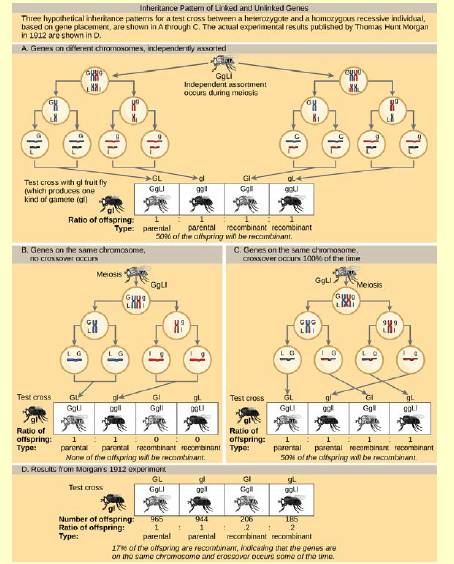
Concept explainers
Figure 13.3 In a test cross for two characteristics such as the one shown here, can the predicted frequency of recombinant offspring be 60 percent? Why or why not?


To analyze:
If the predicted frequency of recombinant offspring can be 60 percent or not.
Introduction:
When a cross takes place between the dominant phenotype trait of an organism and a recessive phenotype trait (recessive homozygous genotype) is called a test cross. This is called a test cross because it helps to test the genotype (homozygous or heterozygous) of an organism.
Explanation of Solution
The organism having a dominant trait whose genotype is unknown is crossed with a homozygous recessive trait and then progeny is analyzed. The homozygous parent will produce only one type of gamete, but the heterozygous individuals will produce two types (in the case of monohybrid) and four types of gametes.
It has been found that any progeny with recessive phenotype predicts that heterozygous is the dominant trait; whereas, when the progeny shows all dominant, subsequently the dominant trait had the homozygous dominant trait. Therefore, in a test cross for two characteristics such as the one shown in the mentioned figure the predicted frequency of recombinant offspring will not be 60%. The predicted frequency of recombinant offspring ranges from 0% (for linked traits) to 50% (for unlinked traits).
Hence, it can be concluded that the predicted frequency of recombinant offspring will not be 60% because it ranges from 0-50% in a test cross for two traits like one referred in this figure.
Want to see more full solutions like this?
Chapter 13 Solutions
Biology 2e
Additional Science Textbook Solutions
Campbell Biology in Focus (2nd Edition)
Chemistry: The Central Science (14th Edition)
Microbiology: An Introduction
Biological Science (6th Edition)
College Physics: A Strategic Approach (3rd Edition)
Concepts of Genetics (12th Edition)
- What is behavioral adaptarrow_forward22. Which of the following mutant proteins is expected to have a dominant negative effect when over- expressed in normal cells? a. mutant PI3-kinase that lacks the SH2 domain but retains the kinase function b. mutant Grb2 protein that cannot bind to RTK c. mutant RTK that lacks the extracellular domain d. mutant PDK that has the PH domain but lost the kinase function e. all of the abovearrow_forwardWhat is the label ?arrow_forward
- Can you described the image? Can you explain the question as well their answer and how to get to an answer to an problem like this?arrow_forwardglg 112 mid unit assignment Identifying melting processesarrow_forwardGive only the mode of inheritance consistent with all three pedigrees and only two reasons that support this, nothing more, (it shouldn't take too long)arrow_forward
- Oarrow_forwardDescribe the principle of homeostasis.arrow_forwardExplain how the hormones of the glands listed below travel around the body to target organs and tissues : Pituitary gland Hypothalamus Thyroid Parathyroid Adrenal Pineal Pancreas(islets of langerhans) Gonads (testes and ovaries) Placentaarrow_forward
 Concepts of BiologyBiologyISBN:9781938168116Author:Samantha Fowler, Rebecca Roush, James WisePublisher:OpenStax College
Concepts of BiologyBiologyISBN:9781938168116Author:Samantha Fowler, Rebecca Roush, James WisePublisher:OpenStax College Biology (MindTap Course List)BiologyISBN:9781337392938Author:Eldra Solomon, Charles Martin, Diana W. Martin, Linda R. BergPublisher:Cengage Learning
Biology (MindTap Course List)BiologyISBN:9781337392938Author:Eldra Solomon, Charles Martin, Diana W. Martin, Linda R. BergPublisher:Cengage Learning Human Heredity: Principles and Issues (MindTap Co...BiologyISBN:9781305251052Author:Michael CummingsPublisher:Cengage Learning
Human Heredity: Principles and Issues (MindTap Co...BiologyISBN:9781305251052Author:Michael CummingsPublisher:Cengage Learning Human Biology (MindTap Course List)BiologyISBN:9781305112100Author:Cecie Starr, Beverly McMillanPublisher:Cengage Learning
Human Biology (MindTap Course List)BiologyISBN:9781305112100Author:Cecie Starr, Beverly McMillanPublisher:Cengage Learning Biology: The Dynamic Science (MindTap Course List)BiologyISBN:9781305389892Author:Peter J. Russell, Paul E. Hertz, Beverly McMillanPublisher:Cengage Learning
Biology: The Dynamic Science (MindTap Course List)BiologyISBN:9781305389892Author:Peter J. Russell, Paul E. Hertz, Beverly McMillanPublisher:Cengage Learning





